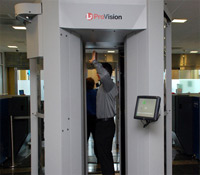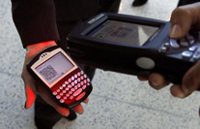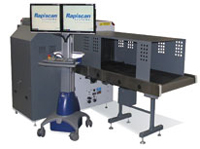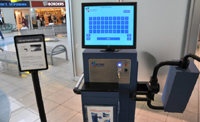 Bob Burns is a Social Media Analyst with the Transportation Security Administration (TSA). Known as “Blogger Bob,” he has become the most familiar face on the TSA Blog, writing numerous posts, participating in videoblog posts, and raising awareness on the TSA Blog Team’s Twitter page.
Bob Burns is a Social Media Analyst with the Transportation Security Administration (TSA). Known as “Blogger Bob,” he has become the most familiar face on the TSA Blog, writing numerous posts, participating in videoblog posts, and raising awareness on the TSA Blog Team’s Twitter page.
Threats are evolving every day. They can be as simple as a crude pipe bomb or as complex as the liquid explosives UK plot that was thwarted in 2006. It would be great if we had some kind of silver bullet technology with a meter that read “Threat or No Threat” to help us detect those threats, but that’s not the reality of where we’re at right now.
While you’ll never catch me or anybody else at TSA saying we can prevent all threats, technology combined with our workforce and our layers of security greatly reduces our vulnerabilities.
This post will focus on some of the technology TSA is currently using. We use a careful analysis of intelligence to determine where best to deploy our technology, so you may not see this technology everywhere.
1. Advanced Imaging Technology (AIT)

Advanced Imaging Technology can detect a wide range of threats to transportation security in a matter of seconds.
You’ve probably heard this technology referred to as the “body scanner.” AIT allows us to see if you have explosives, or non metallic bomb components or weapons under your clothing. Explosives won’t alarm the metal detectors, but AIT will see them.
TSA started piloting this technology in 2007 and now AIT units are being deployed nationally in response to the failed bombing attempt on flight 253.
You basically step into the machine for a couple of seconds and your image is viewed by an officer in an enclosed viewing area where nobody else can see it. The officer viewing your image never sees you in person.
TSA uses two types of imaging technology, millimeter wave and backscatter. Millimeter wave technology produces an image that resembles a fuzzy photo negative. Backscatter technology produces an image that resembles a chalk etching (see adjacent image).
2. Advanced Technology Checkpoint X-ray
This technology is referred to as the AT X-ray. The older X-rays basically provide a top down view. When you’ve got a cluttered bag, things can get lost in the mix and are hard for our officers to see. This leads to extra bag checks and the rerunning of bags through the X-ray so the operator can get a better view.
The AT X-ray allows our officers to get a much better look at your bags by allowing clear HD X-ray images. Officers can look at the content of your bags at various angles. Some AT X-rays have automatic threat detection. AT X-ray units are upgradeable and programmable to allow us to adapt as threats evolve. We’re using two types of AT X-rays. Watch these videos to see how they work: Rapiscan 620DV (wmv, 2.0Mb) and Smiths Detection HI-SCAN 6040aTIX (wmv, 3.3Mb).
This technology can detect the tiniest trace amounts of explosives and it’s used at the checkpoint, checked baggage, and cargo screening areas. It’s used on and inside bags as well as casts, prosthetics, wheelchairs and other places where explosives could be hidden. The technology is also used on shoes and passenger’s hands. A small swab is used to collect the sample and then it’s analyzed.
You can watch demo of Explosives Trace Detection Technology here.
4. Paperless Boarding Pass Pilot

The electronic boarding pass pilot enables passengers to download a boarding pass on their cell phone.
The electronic boarding pass pilot allows passengers to download their boarding pass to their cell phones. This heightens our ability to detect fraudulent boarding passes by using an encrypted 2D bar code containing passenger and flight information. The pilot has expanded to over 66 U.S. airports, plus Frankfurt, Germany.
Here’s how simple it is. You present the barcode on the phone to be scanned and our officer will verify the information from the barcode matches the information on your ID. That’s it. I’ve used this one and I have to say it is extremely easy and you don’t have to worry about your ticket getting lost. (Unless you lose your phone)
Explosive Detection Systems work like MRI machines at hospitals. They take an image of a bag that can be sliced into many pieces and analyzed. The machines are located in our checked baggage areas and automatically detect if a threat might be present and alerts our officers that a closer look is needed. In some airports, you’ll see this technology in the lobby, but in many cases, it is used in-line with the airport’s automated checked baggage system. Watch this video on inline baggage screening.
Due to the failed UK Liquid Explosives Plot, TSA put 3-1-1 in place to limit the amount of liquids that come through our checkpoints. Bottled liquids scanners are used by our Officers to detect potential liquid or gel threats such as the ones used in the plot. They can tell the difference between liquid explosives and common liquids.
TSA utilizes this technology primarily to screen medically necessary liquids in quantities larger than three ounces at our family friendly lanes (Certain medically necessary items as well as items for infants and small children are exempt from 3-1-1).
7. CastScope
If you ever thought that casts or prosthetics would be a great place to hide something, you were right. That’s where the CastScope comes into play. CastScopes use backscatter technology to allow our officers to take a look inside casts and prosthetics. It’s deployed to airports that are near military hospitals or large rehabilitation facilities.
What’s On The Horizon?
TSA is currently working on ways to allow you to keep your shoes on and take liquids through the checkpoint. Different types of shoe scanners are being tested and algorithms are being developed to detect liquid explosives.
To stay in touch with TSA, be sure to follow our blog, Twitter, YouTube, iTunes, and Webpage.
Thanks,
Blogger Bob
TSA Blog Team
All photos and images provided courtesy of TSA.









